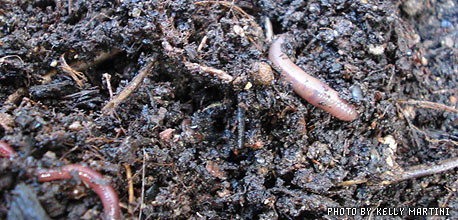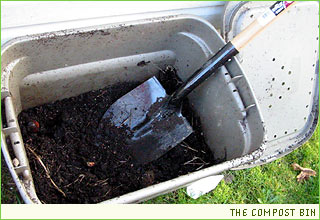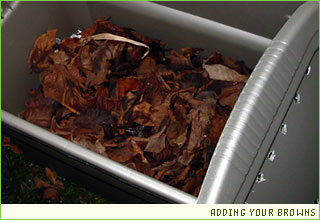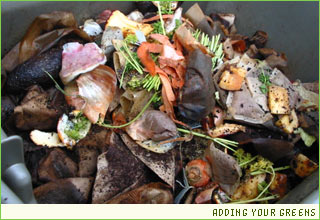
Guest post by Kelly Gilliam
Make this budget conscious compost bin for your deck or small outdoor space.

One benefit to having your own yard and garden is plenty of room. However, some of us live in tight apartments and are forced to have container gardens. Because of space, the urban dweller may conclude that composting is impossible. However, this doesn’t have to be the case.
In my ongoing quest to take more control of my garden right down to the soil I use, I went on a hunt for information on how to make my own small-time composting bin. My initial inspiration was “urban EDEN” by Adam & James Caplin. Since I live in a small area, I don?t require huge amounts of compost. I decided to make my own bin from a Rubbermaid container; it was dark, portable, easy to find and — most importantly — affordable. The following is an account of how I made my bin.
Please note that this how-to is for an outdoor container. It is small enough to fit on a balcony or around the side of a house if you are in a house suite.
Materials:
- Rubbermaid container (1 1/2 feet by 1 1/4 feet.)
- “Browns”: Dead leaves, brown grass clippings, wood, sticks, shredded newspaper, dead plants, rice, pine needles
- “Greens”: Fresh grass and other plant clippings, fruit and vegetable parts, coffee grounds (with or without filter), tea bags, wool, human hair
- Extra newspaper
- A good knife
- Clean the Rubbermaid container, removing all stickers and labels. Take your knife and cut holes along the edges of the bin’s lid, about 1 centimeter wide. I placed these about 3 centimeters apart. Next, cut a few holes in the middle of the lid. These holes will allow air and moisture to circulate.
- Turn your bin over and cut some drainage holes (the water has to go somewhere, right?). I placed two slits in each corner, about a half-centimeter wide and 3 centimeters long. They should be big enough for drainage, but not enough to allow your compost to spill out.
- Rip up your extra newspaper and put it in the bottom of the bin. The shreds should be no more than 1 inch thick, and should fill up the container about 5 to 6 inches.

- Gather all your “browns.” Place them on top of the newspaper. Your bin should be about one-third to one-half full.
- Gather your “greens.” Place these on top of your browns. Your compost bin should be almost full. Make sure to leave a little room at the top though.

- Place your bin outside (if it isn’t already there). If you must place it directly on a deck, a second extra lid can be placed underneath as a drip tray.
- Water. Make sure it’s damp, but not so wet that everything is floating around. If you live in a rainy climate, you can let nature take its course and wet your compost for you.
- Wait.
- In about 3-4 weeks, go out and give your compost a good turn. This will allow the microbes that are decomposing everything to spread around. Repeat every 3-4 weeks.
- Within 6-8 months, you should have a brown, earthy-smelling mixture. That’s your compost!
To my surprise, worms found their way into my compost. If your bin sits on the ground and not on concrete (like a balcony) or on top of the lid then worms will probably find their way into your bin as well. They’re a nice bonus, but definitely not necessary in composting.
Tips:
Starbucks Coffee will hand out their organic waste if you ask them. A warning though: It comes in huge bags, and unless you have somebody to split the bounty with, there won’t be room in your bin for it.
Make sure never to place meat, bones, animal waste or dairy products into your compost. These will only attract rodents and vermin, especially in an urban setting.
Do not use your compost as a replacement for potting soil. It is too heavy for plants to live solely on and might burn them. Instead, mix about one part compost with three parts regular potting or topsoil. This will be more than enough for your plants to get their nutrients.
Add to the bin constantly to allow for good compost throughout the season.
Never add plants that are diseased, as the disease can spread through your compost and be passed on to any plants you use the compost on.
Do not use compost indoors, as it is not sterilized and could carry pests.
Kelly is an urban-dweller from Vancouver, B.C. gardening out of containers due to her city enclosure. Originally from the prairies, she moved out to Vancouver fresh out of high school and was amazed to find that you can garden three-fourths of the year. She is constantly bringing home more and more plants that she really has no more room for. Her favourites are cacti/succulents, herbs and sub-tropicals. Kelly runs Devileye.net in her spare time.